The art of keeping your house cool in the extreme heat of summer is not just one, quick-fix, solution. Success comes from combining a number of different strategies that will keep you more comfortable whilst also saving you money! I have researched different suggestions and tips from private companies, science laboratories as well as government departments and combined them into this post. These can even keep your house cool without A/C!
The key areas are: Avoiding Heat Build Up, Proper Ventilation and the use of Appliances.
Avoiding Heat Build Up
Add Shade !
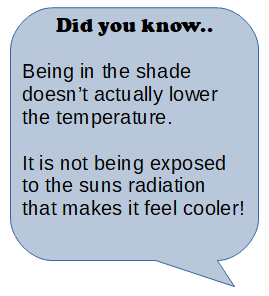
Being in the shade on a hot day can feel as though it is as much as 15 degrees cooler than standing in direct sunlight. Reducing the amount of the sun’s radiation you are exposed to can have a dramatic impact not only on you personally but also on the structure of your house and keeping it cool over a long period of time.
Shade Structures outside keeping you cooler inside!
Compared to the house itself and particularly patios with paving stones, the materials used in shade structures tend to have a much lower thermal mass. This means that when the air flows around them they can recool easily. Therefore, even if you do not intend to sit outside underneath your shade structure during the day, just by having it, you will significantly reduce the speed at which the temperature increases inside your house.
By keeping the walls, paved floors, tiles, etc out of direct sunlight the amount of heat that is transferred into them will be massively reduced. Once hot, these areas then keep radiating that heat back at you, sometimes hours after the sun has gone down.
You can add shade in lots of different ways, Sun Umbrella, Shade Sails, Awnings, Pergolas; check out our Patio Shade guide.
Landscaping – Growing your shade…
Using trees and plants to keep cool is nothing new but when added into the mix of techniques it can have one of the most dramatic impacts at potentially very little cost.

Using trees to shade the roof of your house can reduce the temperature inside by as much as 8-10 degrees (Dr. Leonard Perry, University of Vermont) but this doesn’t mean you need to surround yourself in a dark forest. Even a single tree can make a difference if placed correctly. The suggestion is to plan for shade on the western side of your house.
The outside walls cool down overnight so the morning sun from the east has relatively less impact. Then, during the middle of the day, the sun is much higher and beating down nearer vertically so again has a relatively low impact on the south-facing walls (in the northern hemisphere!). In the afternoon, however, particularly between 3 pm and 5 pm, the air is already warm and the sun is slightly lower and coming from the west so planting on this side will have the greatest benefits.
Even if trees are not possible at your location, you could maybe plant shrubs or vines to form a living shield. Stopping the sun’s radiation heating up the structure of your building will make a big difference. The plant will absorb the sun’s radiation and even traps a cushion of insulating air on the building. You then also benefit from the transpiration (the giving off of water vapour) from their leaves that naturally cools the air around them.
Trees, shrubs, and groundcover plants can also shade the ground and pavement around the home. This reduces heat radiation and cools the air before it reaches your home’s walls and windows. For example you could plant a large bush or row of shrubs to shade a patio or driveway. Plant a hedge to shade a sidewalk. Build a trellis for climbing vines to shade a patio area.
For some suggestions on suitable trees then I found this site helpful: Fast Growing Shade trees for your Yard
Energy Efficient Windows Coverings
About 76% of sunlight that falls on standard double-pane windows enters to become heat. The California Energy Commission even estimates that 40% of a typical commercial building’s cooling requirements are related to solar heat gain through windows.
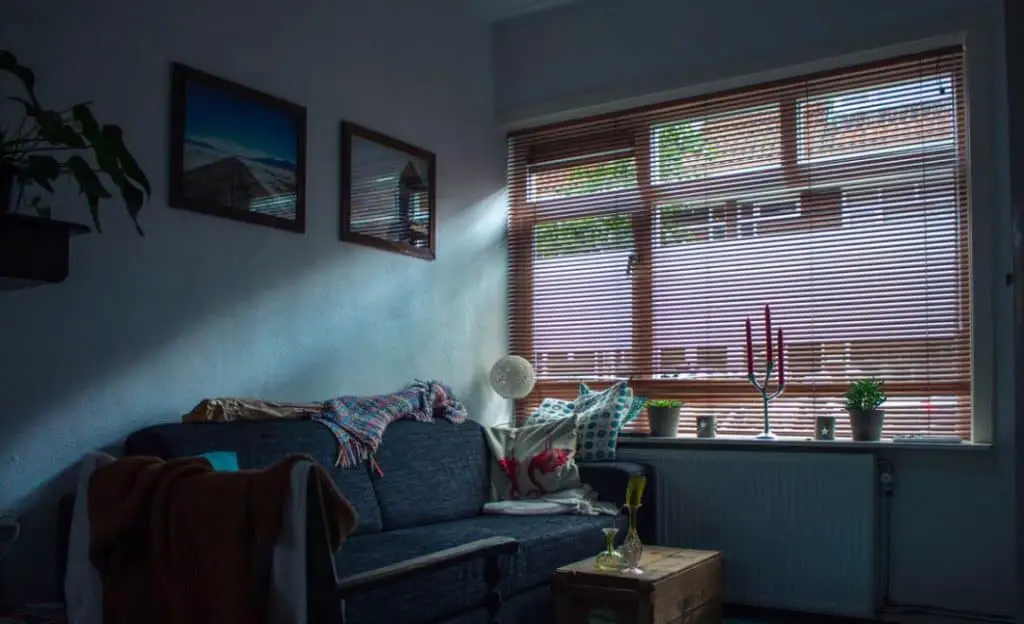
By keeping windows coverings (shutters, shades, blinds, or curtains) closed during the summer you can drastically reduce the heat gain. Ideally, you should keep to pale, neutral colors (only necessary on the side facing the window!) as this will help to reflect the solar rays and the radiant heat that comes with them.
This doesn’t mean you can’t have any natural light but rather in preference you should use those windows that don’t get direct sunlight. You can then alter which coverings are opened and closed throughout the day to maximize the light and reduce the heat.
Horizontal Window blinds can be very popular for benefitting from natural daylight. They can be completely closed for full heat reflection but can also be angled to reflect some of the direct sunlight on to a light-colored ceiling which will diffuse the light without much heat or glare.
Obviously, external shade structures such as awnings, sun shades, etc as mentioned above, can also be installed to add shade to windows.
High-Reflectivity Films
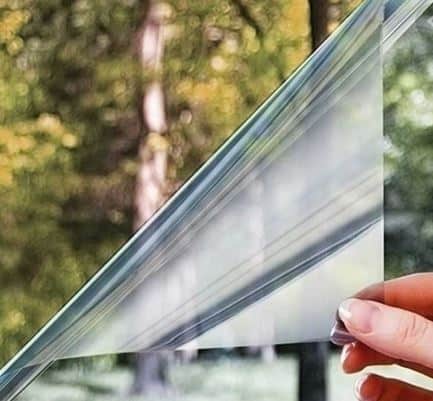
Another thing to consider is adding specialist films to windows. Solar-control films can block as much as 80% of the solar heat coming through glass into a building without altering your view out the window.
These window films are a thin flexible plastic layer that can easily be used for retrofit applications to existing windows.
Insulation to stay cool – Radiant barriers.
It is often forgotten that insulation is as important in keeping cool in the summer as it is in keeping warm in the winter.
Heat flows from warmer to cooler until there is no longer a temperature difference.
This means that any heat gained in the summer must be removed by your cooling system. Properly insulating your home will decrease this ‘heat flow’ by providing an effective resistance to the flow of heat. This is normally done in attic spaces, wall cavities, etc with products like fibreglass rolls, foam boards or loose-fill mineral wool. These will work to keep you cooler in the summer but also keep you warmer in the winter.
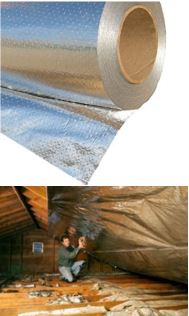
More particularly for keeping cool, however, you should consider a radiant barrier. Most common insulation materials work by slowing conductive heat flow i.e. when the hot thing is actually in contact with the colder thing.
The radiant barriers, usually in attics, consist of a highly reflective material that reflects radiant heat rather than absorbing it. Radiant barriers are for the heat flow that you feel when you are not touching the item, such as the heat inside the attic from the underside of the tiles. They work much like a mirror in reflecting the heat back.
‘Some studies show that radiant barriers can reduce cooling costs 5% to 10% when used in a warm, sunny climate.’ – Energy.gov
External Features Color scheme
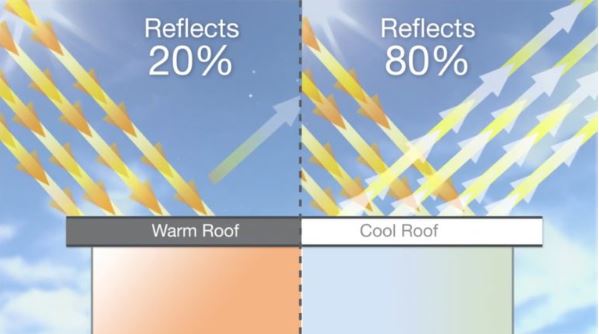
Avoid the darker heat-absorbing colors. In staying with brighter, lighter colors for your walls, roof and patio area you will reflect more of the sun’s rays. A California based Berkeley Lab study found that a clean white roof that reflects 80% of sunlight will stay about 54F cooler on a summer afternoon.
Having a ‘Cool Roof’ can keep an indoor temperature lower by as much as 5 – 9 degrees F. In some settings this can save air-conditioning costs by as much as 40%!
Shade Cloth – Exception to the rule
Sticking to brighter colors is not necessarily true for your choice of shade material/cloth. Lighter colors reflect more sunlight, which means the shade itself will not absorb the heat of the sun as quickly. However, it is not correct to assume that being under a darker shade will be hotter. Yes, the darker color will absorb more of the heat and light, rather than reflecting it, but the shade cloth/material is of such lightweight (often less than an ounce per sq ft / 300GSM) that it doesn’t really retain the heat. The shade cloth’s low thermal mass means that it cools easily just with the flow of air up through the mesh.
Lighter colors also have a lower shade factor (it is brighter underneath them) compared to darker colors of the same material. When light hits a lighter color the higher reflection causes the surface to appear brighter, with more glare, that can then make seeing through the shade harder. If you wish to see through your shade, to admire a particular view for example, then a darker color may be more suitable.
For more shade cloth information check out our article: Types of Material – What do they mean?
Get it Wet – Using Evaporation
Evaporation is a very effective means of cooling but it isn’t restricted to people. By getting your outdoor area wet, even just with a hose or watering can, prior to use and you will benefit from the heat reduction. It can make it seem more humid when it is first done but even having allowed time for it to dry the area will be cooler. It will have lost some of its heat due to the water evaporating. See Appliances below for Misting Systems.
Airflow / Ventilation
This can actually have a greater cooling effect than being in the shade! e.g. on a windy day or when moving fast in an open-top car, it is easy to forget the effects of the sun’s radiation as you can still feel cool. The benefits of heat transfer by convection and evaporation, as experienced with airflow, are more efficient than radiation.
Natural Ventilation
This is using the wind and the natural phenonmenon of hot air rising (known as the ‘chimney effect’) to help cool your home. By adjusting when you open particular windows you can improve its ventilation.
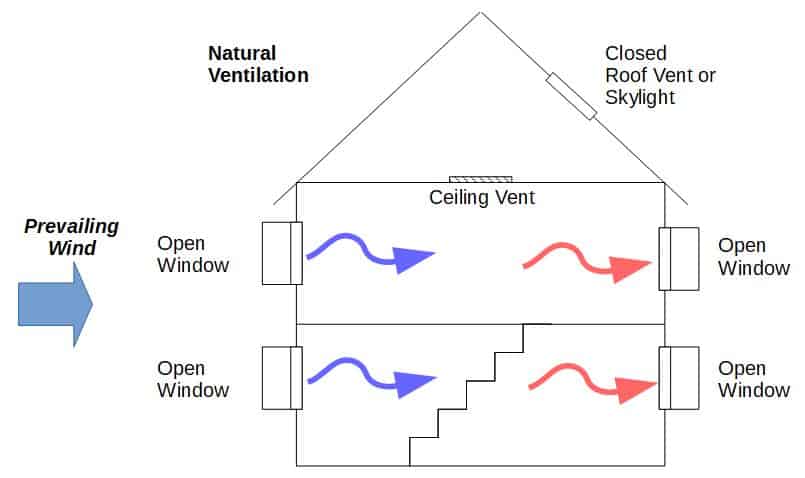
It may seem obvious that wind blowing against one side of your house will force air into those windows. What is often forgotten is that you then need to give the air somewhere to go. So you should also open some windows on the opposite side of the house, with clear routes (open doors etc) for the airflow.
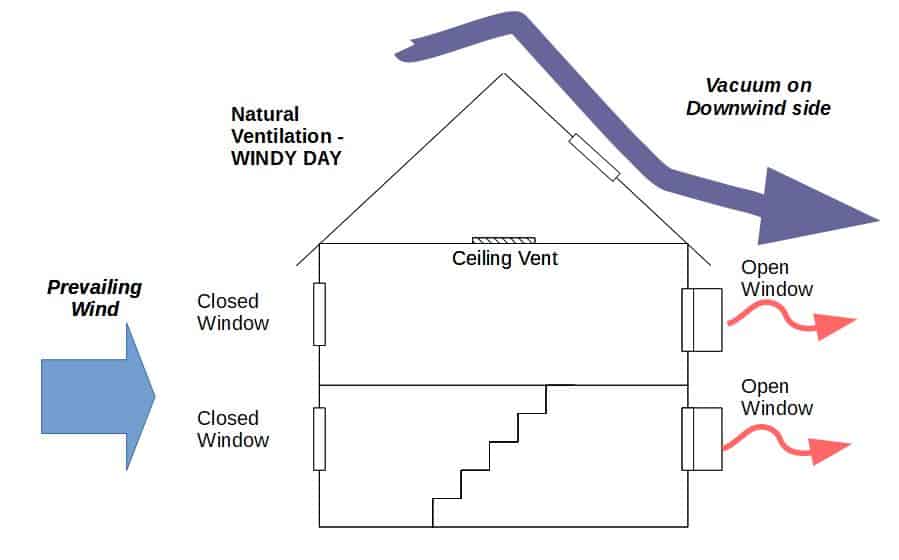
If the direct breeze is too strong you can, however, still benefit. On a windy day a natural vacuum effect will tend to suck air out of the house on the downwind side. You should therfore open the windows on the side opposite the wind for the air to be sucked out and some on one of the non-windy sides to allow air in.
Chimney Effect
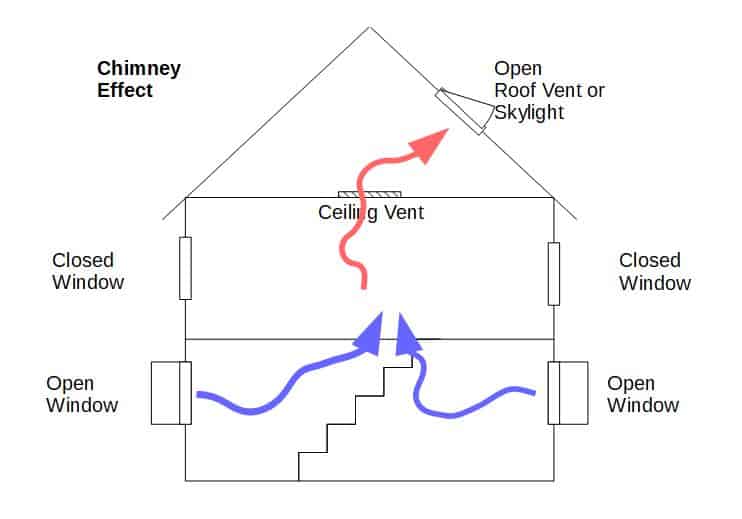
When hot air rises it draws in cooler air underneath to replace it. This effect occurs when cooler air enters on the ground floor or basement, absorbs heat from the room and then rises to the upper floors. If there is a skylight or window open near the top of the house then a flow of air will establish sucking cooler air in at the bottom and hot air escaping at the top.
Powered Ventilation
Cooking, bathing, washing and drying laundry, etc can all pump heat into your home. When you cook, shower or take a bath, use the spot ventilation of a fan/extractor hood to extract the heat and humidity from your home.
Airflow Outside
Try and encourage airflow outside by having any shade as high as practically possible and with changes of height (a flat horizontal roof will trap hot air underneath it). Also consider non-solid shade, such as the mesh used in sun shades or lattice style pergolas so the hot air can move away freely, drawing in cooler air.
Ideally, you should also avoid anything that stops the air flowing along your exterior walls. e.g. If you can use mesh fencing rather than solid panels between front and back yards and between yourself and any neighbors.
Note: This is not the same as using windbreaks. In some areas, where the summer winds are hot and actually heating your home, you may want to establish windbreaks (such as thru planting trees, etc) to stop the wind circulating your home! These windbreaks are usually set up some distance away from your home to break up the local wind flow, they are not stopping and trapping hot air next to the walls.
Cooling Appliances
Air Conditioning
Most people’s first thought for cooling is, of course, Air Conditioning. A/C accounts for ~ 6% of all the electricity produced in the United States, at an annual cost of about $29 billion to homeowners!
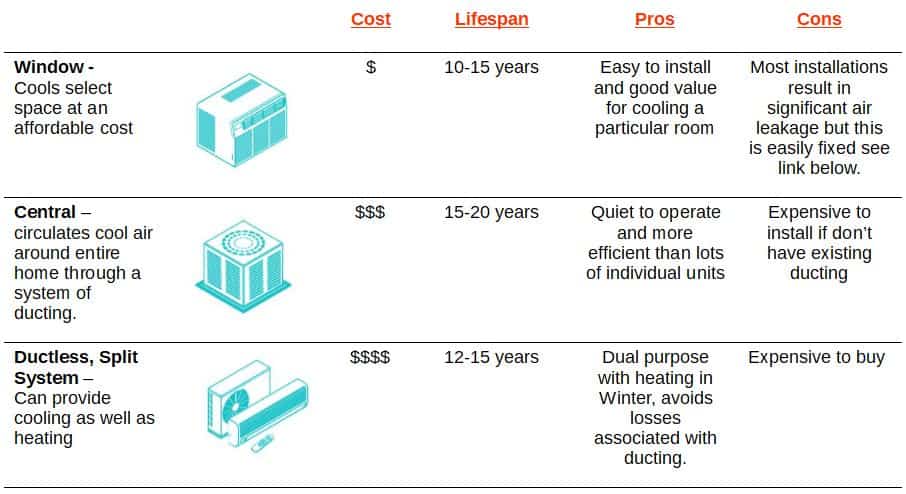
For more information specific to A/C then check out our other post here: An Engineers Tips and Tricks when your Air Conditioning is NOT keeping your house cool!!
Evaporative Coolers / Swamp Cooler
An Evaporative cooler works by blowing less humid outside air across water saturated pads that can make the air 15 – 40 degrees F cooler. They are ~50% cheaper to install than central A/C and only use about 25% of the energy.
Key Benefits:
- Cost; fraction of the cost to run compared to Central A/C
- Clean air introduced from the outside and the expelling of stale air; A/C just recirculates the same air.
Drawbacks:
- Not suitable for humid climates; they work by adding moisture to the air so they are less suitable to climates where the air is already humid.
- Significant Maintenance; when running they require more frequent maintenance ~ each month
- Use water; they use water so may not be suited to areas with limited supply
- Not as Cool; They do not cool the air as much as A/C.
Whole House Fans
For larger homes owners should consider Whole House Fans. They work by sucking air into the property through open windows, it is then drawn into the attic space and expelled. The airflow through the house will absorb heat as well as bringing in cooler air from outside.
The key benefits:
- Cost; fraction of the cost to run compared to equivalent Central A/C or multiple Window units
- Speed with which they can be effective; can cool a home in a few minutes
- Clean air introduced from the outside and the expelling of stale air; A/C just recirculates the same air.
They are a very simple, yet effective method of cooling your home but are not suitable for everyone.
- They are less suited to humid climates where temperature swings between day and night are only small.
- They can also be noisy so a good quality fan unit and proper installation are important.
Unless you can be sure to have clean air and cooler outside temperatures, at least over night, they may not be for you.
Circulating Fans
Circulating fans include ceiling fans, table fans, floor fans, and fans mounted to poles or walls. These fans create a wind-chill effect that will make you more comfortable in your home, even if it’s also cooled by air conditioning. Ceiling fans are usually the most effective as they circulate all the air in a room to create a draft. Table and floor fans can also be effective but the more direct airflow can be troublesome where objects or papers will be disturbed by the breeze.
The use of a ceiling fan can allow you to raise the thermostat setting about ~4 degrees in that room without impacting your comfort.
NOTE: Turn off fans when you leave a room; fans cool people, not rooms, by creating a wind-chill effect.
Misting Systems
Misting systems rely on the evaporation of water, this process absorbs heat energy, thus lowering the surrounding air temperature. This is essentially using the same method of cooling as our bodies when we sweat. The immediate evaporation of the mist can reduce the air temperature by as much as 20ºF. The big difference comes in the quality of the system that is used.
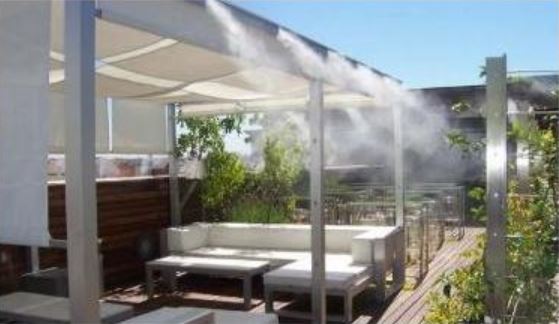
Basic / Cheaper systems rely on your home water pressure to create the water droplets that are sprayed into the air. The more advanced / expensive systems have a pump to create a much higher pressure system which means the water drops that are sprayed are much, much smaller. The smaller drops evaporate more easily and therefore quicker.
The more advanced systems cool the air making it feels more refreshing without you actually getting wet in any way. The cheaper systems can still be effective but unless it is very hot and dry some of the water drops will not evaporate before falling to the ground. This may not be a problem if the system is suitably distant and used to create a ‘curtain’ of cooler air around an outside space. It may even be useful if used to help water plants but it can be unwanted if it gets you wet in the process.
Regardless of which version you purchase, in areas with a high humidity (consistently over 80%) they are unlikely to be that effective. This is due to the reduced evaporation with the air being almost saturated already.
Dehumidifiers; Yes but No
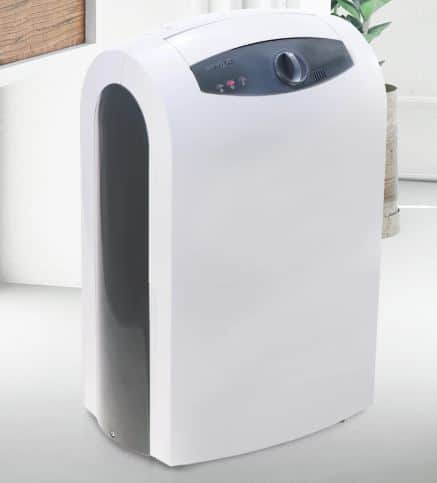
I have seen mentioned on a few sites the use of dehumidifiers to help you keep cool. In most cases The theory for this is sound as when the humidity/moisture level is high, our ability to cool through perspiration is inhibited. By removing moisture from the air it makes it easier for us to perspire (without streams of sweat) and that in turn keeps us feeling cooler.
However… it is worth stating that in order to get the most benefit you will need a whole-house dehumidifier or one that uses ducting. The reason is that the portable models tend to get warm in the process of removing the moisture from the air. This additional heat may make its use for cooling less suitable.
However… dry air is far more comfortable even when significantly warmer. It is easier to feel comfortable in 100F+ desert temperatures whereas, for example, the humid summer temperatures of Midwestern states can feel muggy and sticky even in the 80F-90F temperatures.
Note: A/C units will also dehumidify the air that they process but if the air is already very dry then they can be more efficient.
The Ultimate Solution
The best solution would obviously include all of the above features (allowing for your regional humidity regarding suitable appliances) but as some features such as growing trees and adding radiant insulation are not instantly available I have listed the elements that should be available to everyone almost immediately.
- Early mornings you have windows open on both sides of the house and at the top to encourage both a through breeze of cool fresh air and to utilize the chimney effect where hot air rises.
- Ideally, your windows have solar film retrofitted otherwise any windows with direct sunlight should have their curtains/shutters/blinds closed.
- If you are leaving for work then you would close lower windows (for security) and then close any window covers that will get direct sunlight during the day.
- If possible then leave a shaded window or air vent at the top of the house open to allow hot air to escape.
- While out it is suggested that you do not leave fans on or even your A/C as it will only be using electricity and increasing wear and tear without significant benefit.
- Ideally, your A/C unit has a ‘smart’ thermostat that you can program to start before you get home.
- If the sun is still high then wetting any outside space before going outside can help reduce the temperature.
- Turning on a fan as well as your A/C can make a big difference but only in the room you are in, they do not make rooms cooler, only people, through greater evaporation.
For more information specific to A/C then check out our other post here: An Engineers Tips and Tricks when your Air Conditioning is NOT keeping your house cool!!
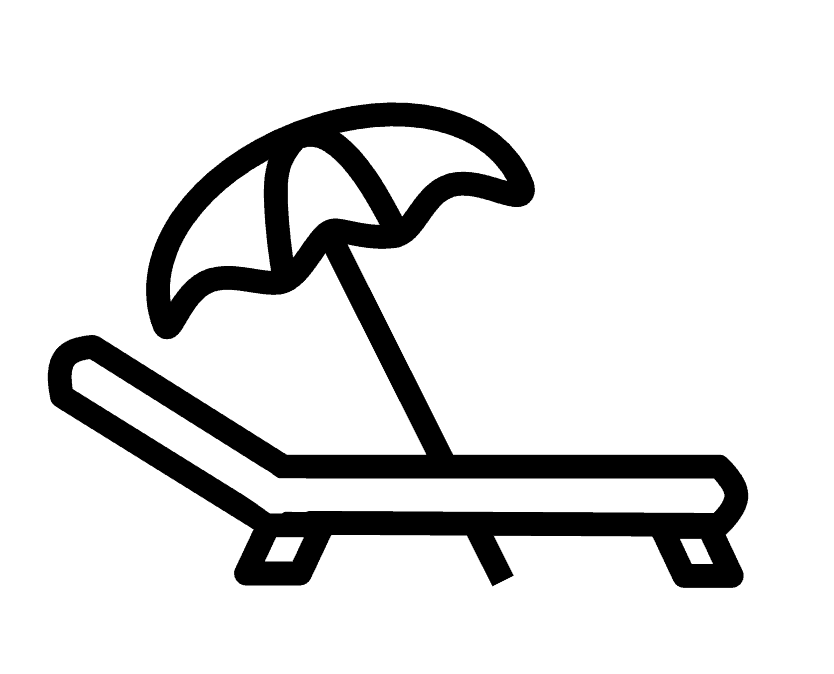
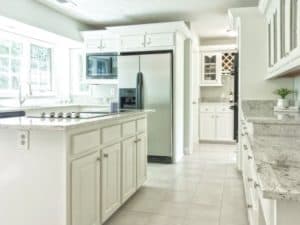

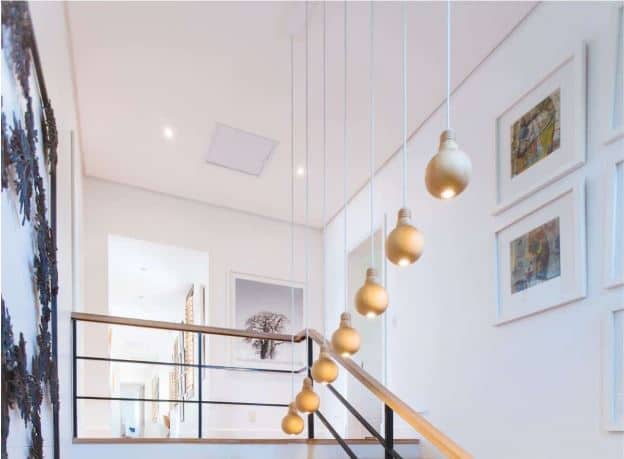
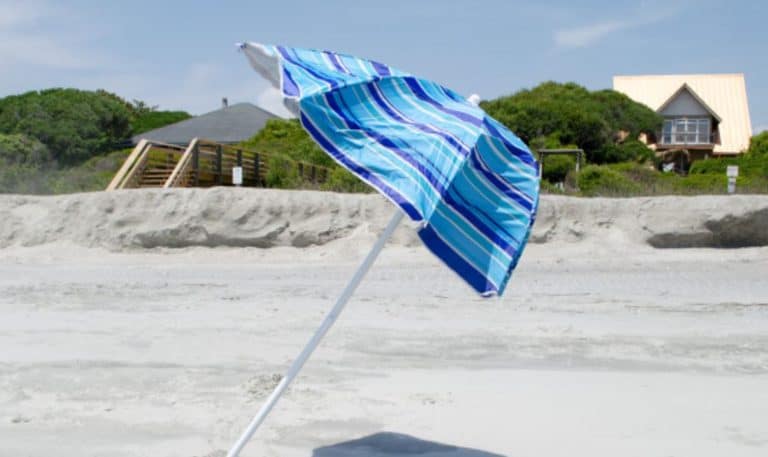
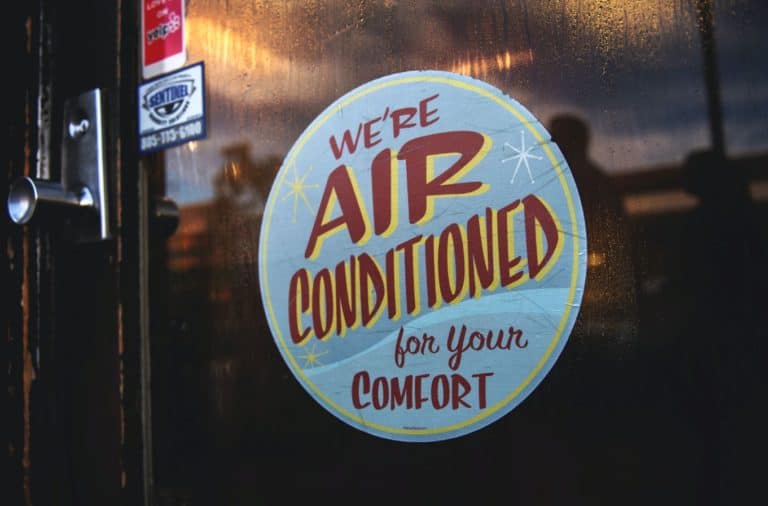
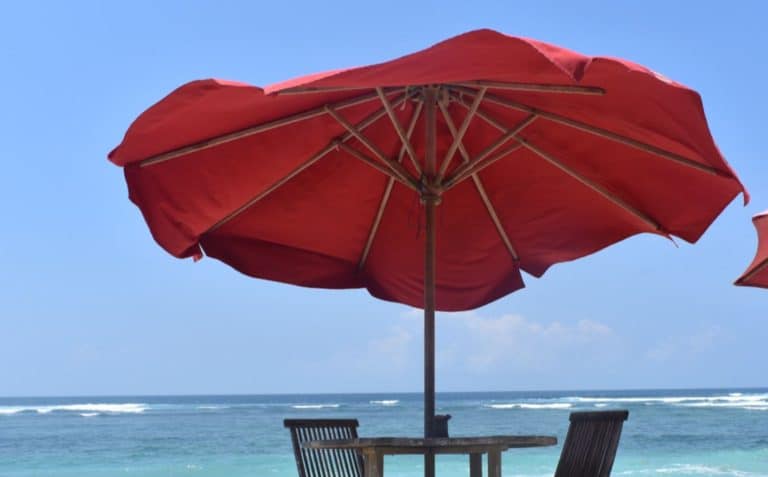
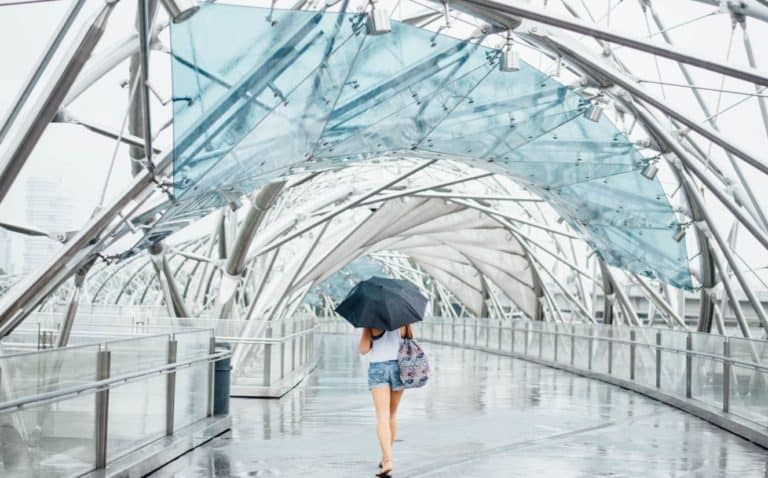
Comments are closed.